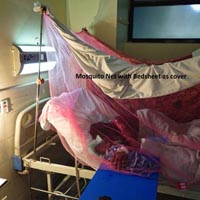Mosquito net as an environmental aid in the management of pemphigus

Submitted: 24 April 2021
Accepted: 13 December 2021
Published: 2 February 2022
Accepted: 13 December 2021
Abstract Views: 3859
PDF: 233
HTML: 17
HTML: 17
Publisher's note
All claims expressed in this article are solely those of the authors and do not necessarily represent those of their affiliated organizations, or those of the publisher, the editors and the reviewers. Any product that may be evaluated in this article or claim that may be made by its manufacturer is not guaranteed or endorsed by the publisher.
All claims expressed in this article are solely those of the authors and do not necessarily represent those of their affiliated organizations, or those of the publisher, the editors and the reviewers. Any product that may be evaluated in this article or claim that may be made by its manufacturer is not guaranteed or endorsed by the publisher.

 https://doi.org/10.4081/hls.2022.9828
https://doi.org/10.4081/hls.2022.9828



